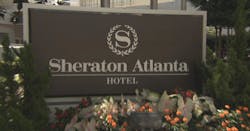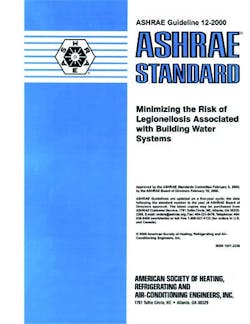Editor's Note: Legionella, Lead and Infrastructure
Amid the insane buzzsaw of accelerated news cycles and relentless social media that drives modern life, it is not always easy to separate the wheat from the chaff in this Information Age.
But there are two clusters of public health-related engineering stories that have also been in the news in recent months and I want to highlight them here. The first is the latest front in our industry’s ongoing, 43-year-old war with Legionella, the pneumonia-causing bacterium associated with building water and air-conditioning systems. It draws its name, of course, from the deadly 1976 outbreak during an American Legion convention at a Philadelphia hotel.
This summer, Legionnaires’ disease reared its head in Atlanta, where a new outbreak of the lung infection caused the the downtown Sheraton Hotel to close its doors from July 15 to August 15. No doubt, more than a few of you stayed at that hotel during the most recent AHR Expo last January in Atlanta. In the spring and early summer, some 13 cases of the infection were confirmed at the hotel, including one fatality. At press time, another 53 cases were also likely to be confirmed.
Last month, the Georgia Department of Public Health confirmed test results indicated Legionella bacteria was in the hotel’s cooling tower and in a decorative fountain in the atrium.
Similarly, in June, public health officials in a Columbus OH suburb confirmed that the new Mount Carmel Grove City hospital had bacteria in its hot water system that also caused a Legionnaires’ disease outbreak. The result: 16 confirmed cases and one death. Investigators blame “inadequate disinfection” before the hospital opened April 28.
Needless to say, related lawsuits are now flying in Georgia and Ohio.
With that in mind, Atlanta-based ASHRAE now is actively reissuing and updating the resources it has developed over the years to help reduce the risk of Legionella, including Standard 188, which provides a comprehensive approach to help prevent the growth and spread of Legionella within building water systems. ASHRAE collected public comments in 2018 to inform the standard’s new Guideline 12.
Getting the Lead Out
Meanwhile, aging urban water systems are facing different, but even more compelling emergencies. This past spring, Newark NJ officially joined the growing list of U.S. municipalities grappling with lead leaching into the public water supply.
On Aug. 26, state, city and Essex County NJ officials announced a new, $120-million plan to replace 18,000 old pipes in Newark over the next 30 months. Since March, the city says it has already replaced some 800 pipes.
Before Newark’s woes became public, of course, Flint MI had been the poster child for this problem. But cities from Washington DC and Milwaukee to Pittsburgh and Portland OR all have faced or are facing lead crises of varying levels. And they are just the tip of the iceberg.
“Drinking water is delivered via one million miles of pipes across the country,” states ASCE’s 2017 Infrastructure Report Card. “Many of those pipes were laid in the early to mid-20th century with a lifespan of 75 to 100 years.”
Do the math, engineers.
At the very least, that means our industry is looking at another 25 years of increasingly urgent opportunities. Will we be ready to meet these mounting challenges?
To see more Edtor's Notes, click here.
About the Author
Rob McManamy
Editor in Chief
An industry reporter and editor since 1987, McManamy joined HPAC Engineering in September 2017, after three years with BuiltWorlds.com, a Chicago-based media startup focused on tech innovation in the built environment. He has been covering design and construction issues for more than 30 years, having started at Engineering News-Record (ENR) in New York, before becoming its Midwest Bureau Chief in 1990. In 1998, McManamy was named Editor-in-Chief of Design-Build magazine, where he served for four years. He subsequently worked as an editor and freelance writer for Building Design + Construction and Public Works magazines.
A native of Bronx, NY, he is a graduate of both the University of Virginia, and The John Marshall Law School in Chicago.
Contact him at [email protected].

